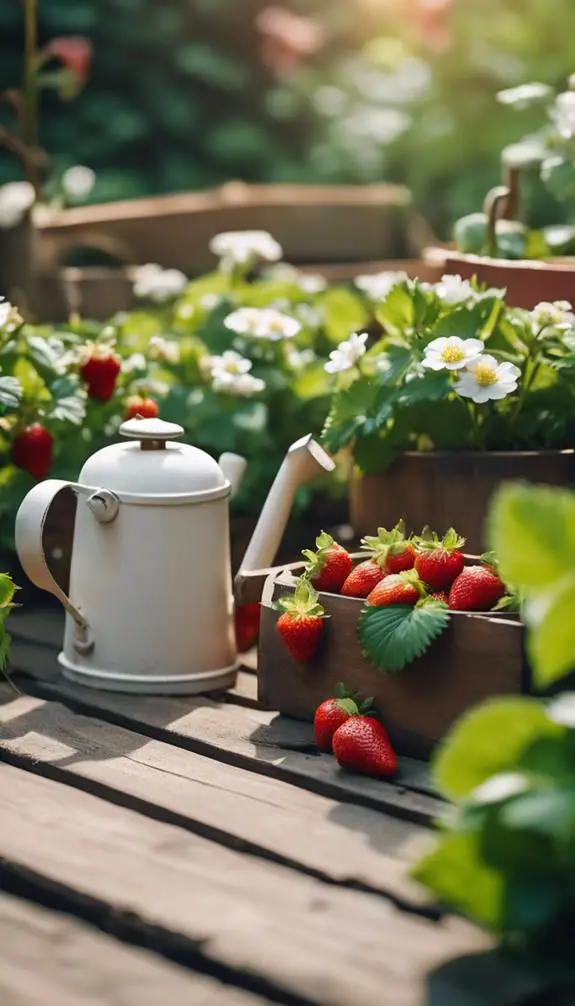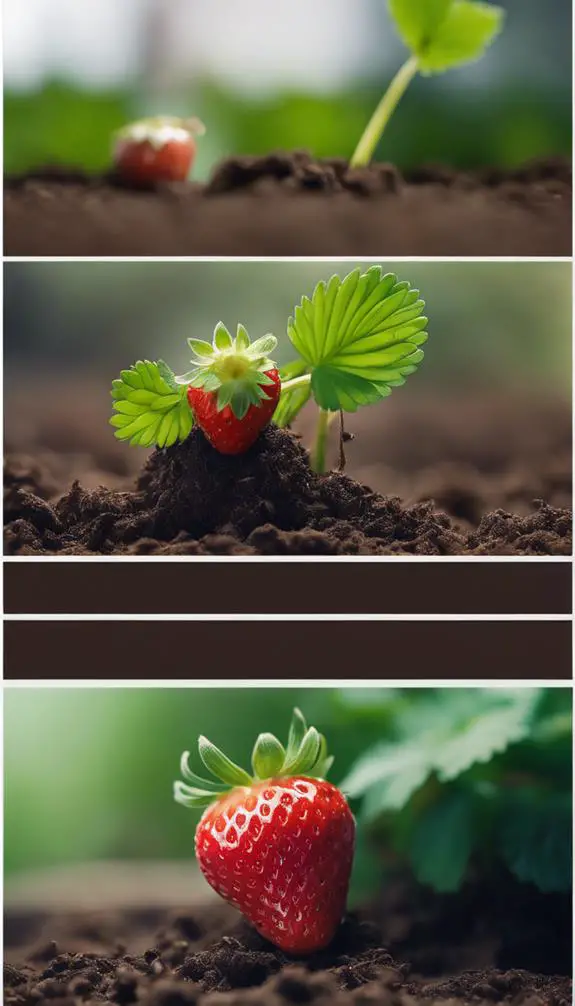As you begin your strawberry-growing journey, you're likely wondering where to start. You've probably heard that strawberries are easy to grow, but you also know that a little planning and preparation can make all the difference. By choosing the right variety for your climate and desired harvest type, you'll set yourself up for success. But that's just the beginning – you'll also need to prepare the soil, source healthy plants, and provide the right conditions for your strawberries to thrive. Get these basics right, and you'll be enjoying fresh, juicy strawberries in no time – but what's the secret to keeping your plants happy and productive?
Summary
- Select a suitable strawberry variety that thrives in your local climate and desired harvest type (everbearing, June-bearing, or day-neutral).
- Prepare the soil by conducting a pH test, adding organic matter, and balancing nutrients (NPK) for optimal growth and fruit production.
- Plant strawberries 12-18 inches apart in well-draining containers or beds with full sun and consistent moisture, using a balanced fertilizer schedule.
- Mulch around plants to retain moisture, suppress weeds, and regulate soil temperature, and water deeply once or twice a week depending on weather conditions.
- Prune plants regularly to maintain shape, promote healthy growth, and encourage fruiting, and monitor for pests and diseases to ensure a successful harvest.
Choosing the Right Strawberry Variety
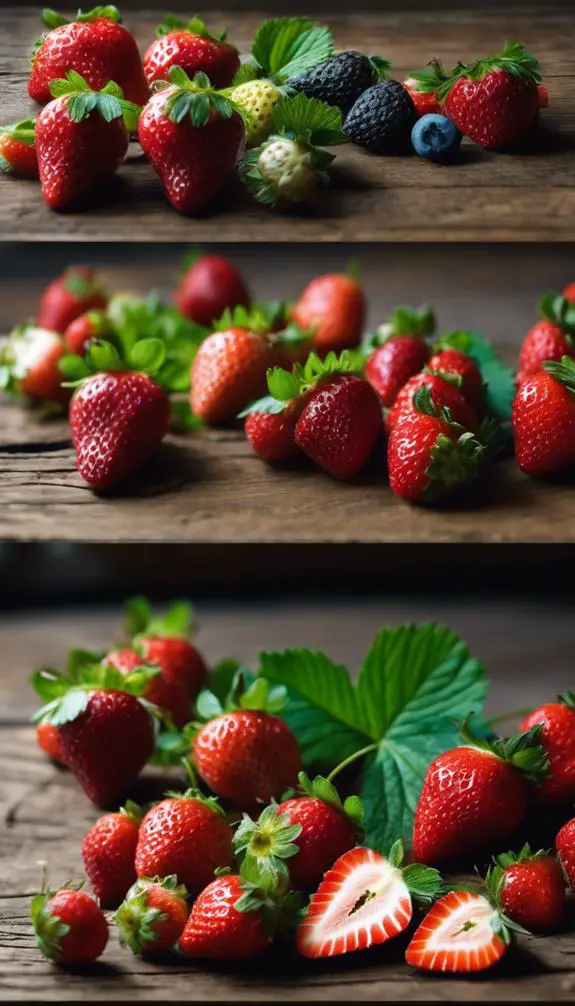
Selecting the right strawberry variety is crucial for a successful harvest, as different types thrive in specific conditions and offer unique characteristics.
You'll find over 600 strawberry types, each with its own strengths and weaknesses. Some varieties excel in warmer climates, while others prefer cooler temperatures.
You'll also encounter different flavor profiles, ranging from sweet and juicy to tart and tangy.
Consider the 'Everbearing' variety for continuous production, or 'June-bearing' for a single, large harvest.
'Day-neutral' strawberries are ideal for indoor growing, as they're less sensitive to daylight hours.
Research the specific needs and characteristics of each variety to confirm you're choosing the best fit for your growing conditions and desired flavor profile.
Preparing the Soil for Strawberries
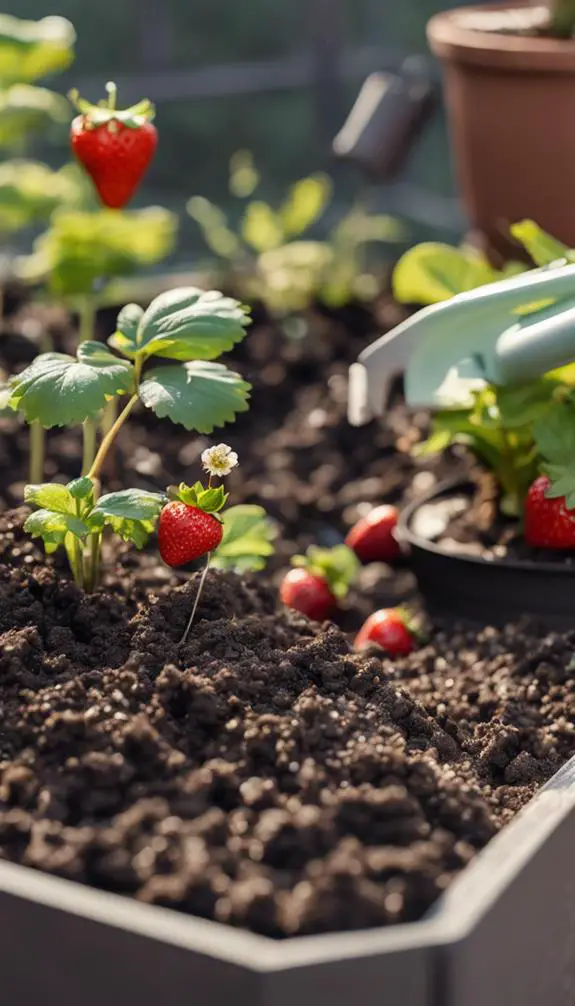
Now that you've chosen the perfect strawberry variety, it's time to focus on the foundation of your strawberry bed: the soil.
Before planting, you need to certify the soil is suitable for strawberries. Start by conducting a soil test to determine the pH level and nutrient content.
Strawberries thrive in slightly acidic soil with a pH between 5.5 and 6.5. If your soil is too alkaline or acidic, you'll need to adjust it through pH balancing.
Add organic matter like compost or manure to improve the soil structure and fertility. Based on the test results, you may also need to add specific nutrients like nitrogen, phosphorus, or potassium.
Sourcing Healthy Strawberry Plants

You'll want to start by selecting healthy plants with bright green leaves and no signs of pests or disease.
Next, choose a variety that's well-suited to your climate and the type of strawberries you want to grow – June-bearing, ever-bearing, or day-neutral.
When buying from a nursery, look for plants that are certified disease-free and resistant to common strawberry diseases, such as powdery mildew or crown rot.
Selecting Healthy Plants
With strawberry cultivation, the quality of your plants at the outset can make all the difference in the success of your crop.
When selecting healthy plants, you'll want to conduct a thorough strawberry inspection. Start by examining the roots, making sure they're white, firm, and free of rot or damage.
Next, inspect the leaves and stems for signs of disease or pests. Look for vibrant green color and sturdy stems. During plant evaluation, check for any signs of nutrient deficiency, such as yellowing leaves or weak growth.
Choose plants with a robust, bushy appearance and avoid those with weak or spindly growth. By selecting healthy plants, you'll set yourself up for a successful strawberry harvest.
Choosing Right Variety
How do you guarantee that your strawberry plants will thrive and produce a bountiful harvest?
By choosing the right variety, you set yourself up for success. With a rich strawberry history spanning over 2,000 years, there are numerous varieties to select from, each offering unique flavor profiles.
Consider factors like climate, soil type, and desired flavor profile when making your selection. Day-neutral strawberries, like 'Albion' and 'Everbearing', produce fruit continuously, while June-bearing varieties, like 'Earliglow' and 'Redstar', yield one large crop.
Look for disease-resistant varieties, such as 'Fern' and 'Florence', to minimize maintenance. By selecting the right variety, you'll be enjoying a juicy, sweet harvest in no time.
Buying From Nursery
Now that you've selected the ideal strawberry variety for your climate and desired flavor profile, it's time to procure healthy plants from a reputable nursery.
When selecting a nursery, look for ones that specialize in strawberry plants and have a good reputation among local gardeners. Check online reviews and ask for referrals to guarantee you're getting high-quality plants.
Inspect the plants before purchasing, checking for signs of disease, pests, or nutrient deficiencies. Choose plants with vibrant green leaves, sturdy stems, and no signs of damage.
Healthy plants will give you a head start on growing delicious strawberries. Prioritize strawberry quality when making your selection, as it will directly impact your harvest's success.
Planting Strawberries in Containers

You can grow strawberries in containers, which is a great option if your outdoor space is limited or your soil is poor.
When selecting a container, guarantee it has a minimum depth of 6-8 inches to accommodate the strawberry plant's roots.
For peak growth, plant strawberries 12-18 inches apart, depending on the variety.
This spacing allows for proper air circulation and sunlight penetration.
Use a well-draining potting mix specifically designed for containers, and water thoroughly after planting.
Make sure the container has drainage holes to prevent waterlogged soil.
With proper care, your container-grown strawberries will thrive and produce a bountiful harvest.
Planting Strawberries in the Ground

Since strawberries prefer well-draining soil and full sun, choose a location that receives at least six hours of direct sunlight daily and has soil with a pH between 5.5 and 6.5.
Prepare the ground by loosening the soil to a depth of 12 inches and mixing in organic matter like compost or well-rotted manure. This will improve soil structure and fertility.
For strawberry spacing, plant them 18-24 inches apart, depending on the variety. Dig holes that are the same depth as the pot and twice as wide. Gently remove the strawberry plant from its container and place it in the hole, making sure the crown (where the roots and stems meet) is at soil level. Fill in the hole with soil and gently firm it around the roots.
Watering and Mulching Strawberries
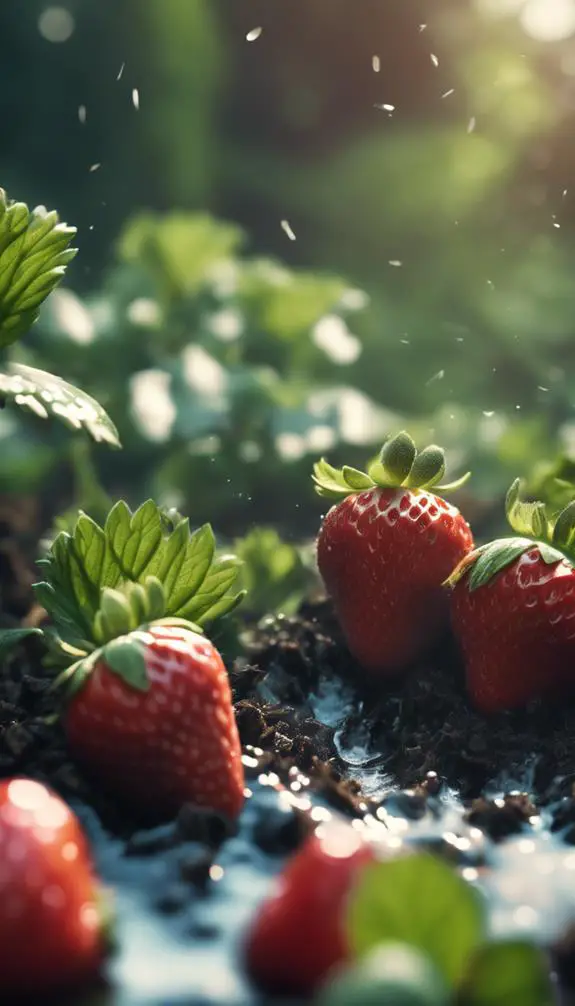
As strawberry plants begin to establish themselves, they'll require consistent moisture, especially during their first few weeks in the ground.
You'll want to water them deeply once or twice a week, depending on weather conditions. Aim for about 1 inch of water per week, either from rainfall or strawberry irrigation.
Mulching around the plants will help retain moisture, suppress weeds, and regulate soil temperature. You'll reap multiple mulch benefits, including reduced water evaporation and increased fruit production.
Apply a 2- to 3-inch layer of organic mulch like straw or wood chips around the plants, keeping it a few inches away from the crowns.
As you continue to water and mulch your strawberries, they'll thrive and produce a bountiful harvest.
Providing Optimal Sunlight Conditions
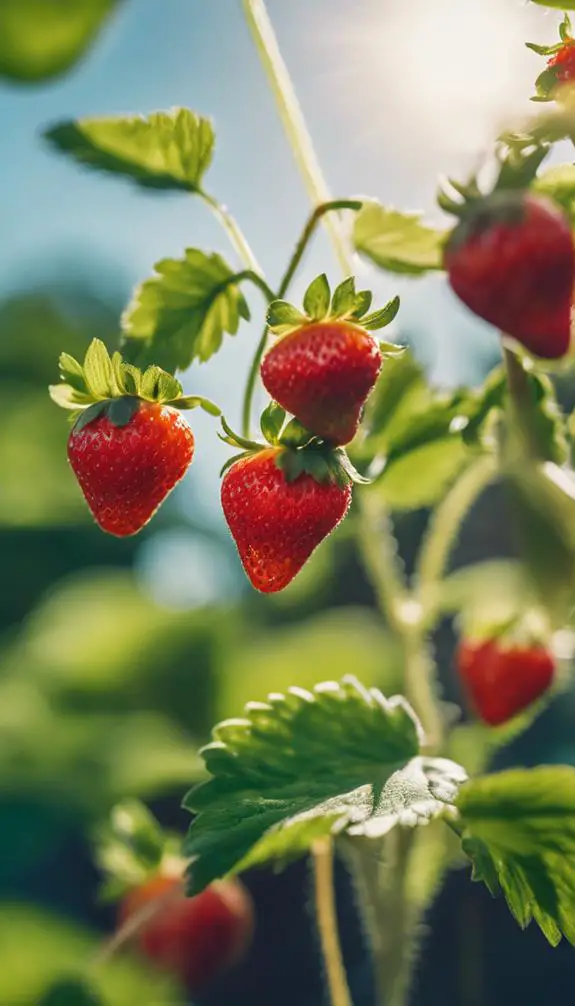
You'll want to provide your strawberries with at least 6 hours of direct sunlight per day, as this will promote healthy growth and fruit production.
However, you should also consider providing shaded afternoon relief, especially in warmer climates, to prevent scorching and heat stress.
Direct Sunlight Hours
Strawberries require a minimum of six hours of direct sunlight per day to produce a bountiful harvest.
You'll want to guarantee your strawberry plants receive direct sunlight during the peak sun hours of the day, typically between 9 am and 3 pm.
During this time, sunlight intensity is at its highest, promoting healthy growth and fruit production.
Daily scheduling is vital to achieve this.
Consider the orientation of your garden or strawberry bed to maximize sunlight exposure.
If possible, position your plants on a south-facing slope or wall to capture the most intense sunlight.
Shaded Afternoon Relief
Position your strawberry plants to receive shaded afternoon relief, a essential complement to the direct sunlight hours they require.
This respite from intense heat is pivotal, especially during summer months when temperatures soar. By providing shaded retreats, you're creating a haven for your strawberries to recover from the scorching sun.
This afternoon shade also helps prevent water loss, reducing the need for frequent watering. Strategically place your plants under a tree or install a trellis with a shade-providing canopy to create a summer escape for your strawberries.
This thoughtful planning will help your plants thrive, even on the hottest days.
Fertilizing Strawberry Plants Regularly
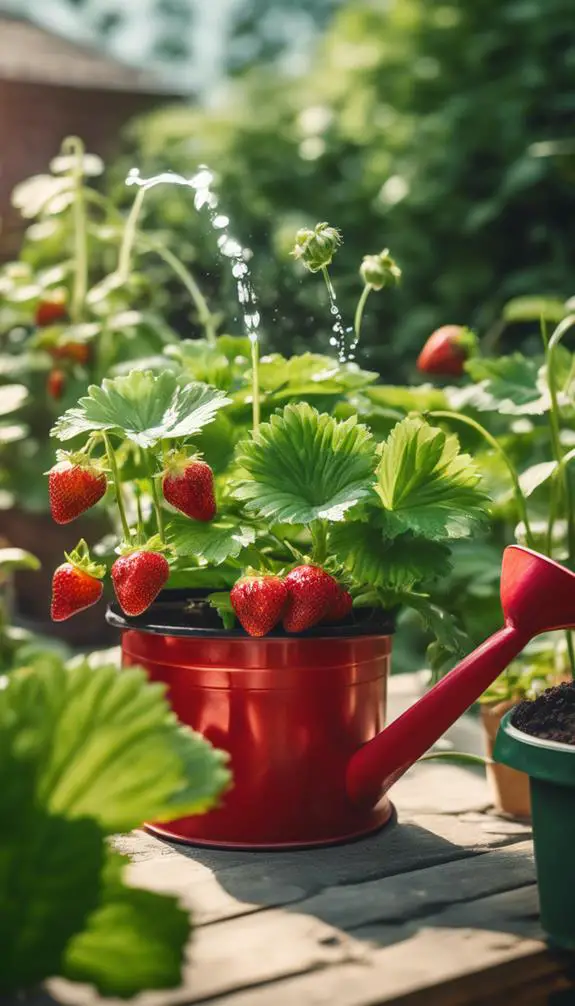
Nutrient uptake is essential for strawberry plants to thrive, and regular fertilization plays a pivotal role in this process.
You'll want to provide your strawberry plants with the necessary strawberry nutrients to promote healthy growth and fruit production. Create a fertilizer schedule to guarantee your plants receive the right nutrients at the right time.
Aim to fertilize your strawberry plants every 2-3 weeks during the growing season. Use a balanced fertilizer with a mix of nitrogen, phosphorus, and potassium (NPK) to support overall plant health.
Consider using organic fertilizers or compost to provide slow-release nutrients. By sticking to your fertilizer schedule, you'll be rewarded with bountiful strawberry harvests.
Pruning Strawberry Plants for Success
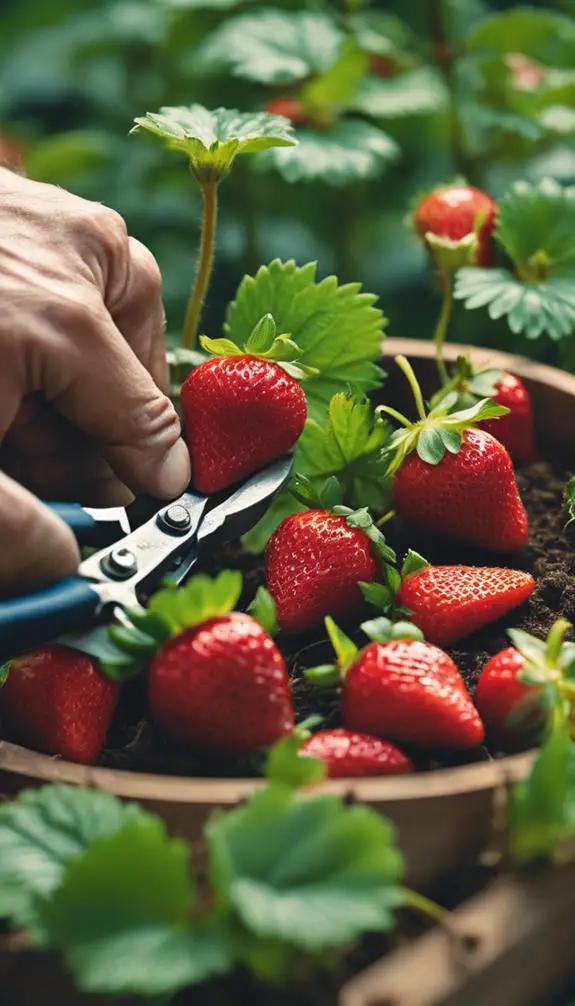
Every few weeks, you'll need to prune your strawberry plants to maintain their shape, promote healthy growth, and encourage fruiting.
Pruning involves cutting back or removing certain parts of the plant to direct its energy towards fruit production.
Start by removing any dead or damaged leaves or stems, as these can harbor disease and pests.
Next, trim back the strawberry crowns to encourage bushy growth and more fruiting sites.
Finally, remove any runners that are growing outside of the container or bed, as these can divert energy away from fruit production.
Managing Pests and Diseases Naturally
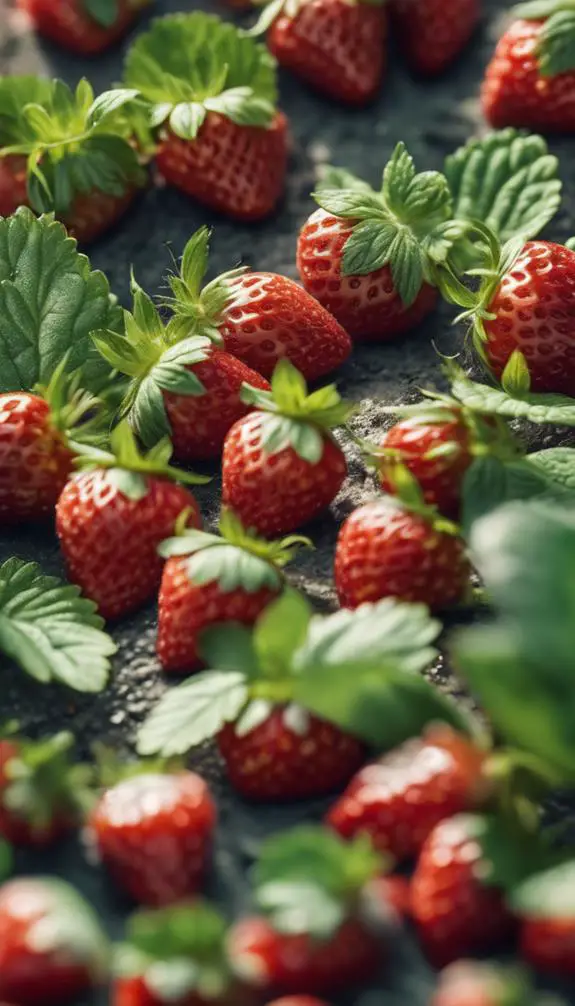
You'll want to protect your strawberry plants from pests and diseases that can hinder their growth and yield.
Natural pest repellents, such as neem oil and pyrethrin, can be effective in deterring common pests like aphids and slugs.
Natural Pest Repellents
How do pests and diseases find their way into your strawberry patch, and what can you do to stop them naturally?
Pests and diseases can enter your patch through contaminated soil, infected plants, or even on your tools.
To prevent infestations, use natural pest repellents like neem oil. Neem oil benefits include its ability to disrupt insect hormone systems, preventing them from reproducing.
Garlic spray effectiveness lies in its ability to repel aphids, spider mites, and other pests. Mix crushed garlic with water and spray it on your plants to keep pests at bay.
You can also introduce beneficial insects like ladybugs and lacewings to your patch to prey on pests.
Common Strawberry Diseases
Strawberry patches are susceptible to various diseases, including powdery mildew, botrytis, and leaf spot, which can substantially reduce yields and affect fruit quality.
As you grow strawberries, you'll need to monitor your plants for signs of disease. Fungal infections like powdery mildew and botrytis can spread quickly, while bacterial blight can cause lesions on leaves and stems.
Leaf spot, a common issue in humid climates, can lead to defoliation and reduced fruiting. You'll need to identify diseases accurately to take effective action.
Be on the lookout for white powdery patches, gray mold, black spots, or yellowing leaves, and take note of any unusual odors or slimy texture.
Organic Control Methods
Your strawberry patch's defenses against disease rely on a combination of good cultural practices and organic control methods.
To manage pests and diseases naturally, you'll want to implement crop rotation and companion planting strategies. Crop rotation involves rotating your strawberry crop with other plants that break disease cycles, such as clover or rye.
Companion planting, on the other hand, involves planting certain species alongside your strawberries that repel pests or attract beneficial insects. For example, planting marigolds with strawberries can deter nematodes, while basil repels aphids and attracts pollinators.
Supporting Strawberry Plants as Needed
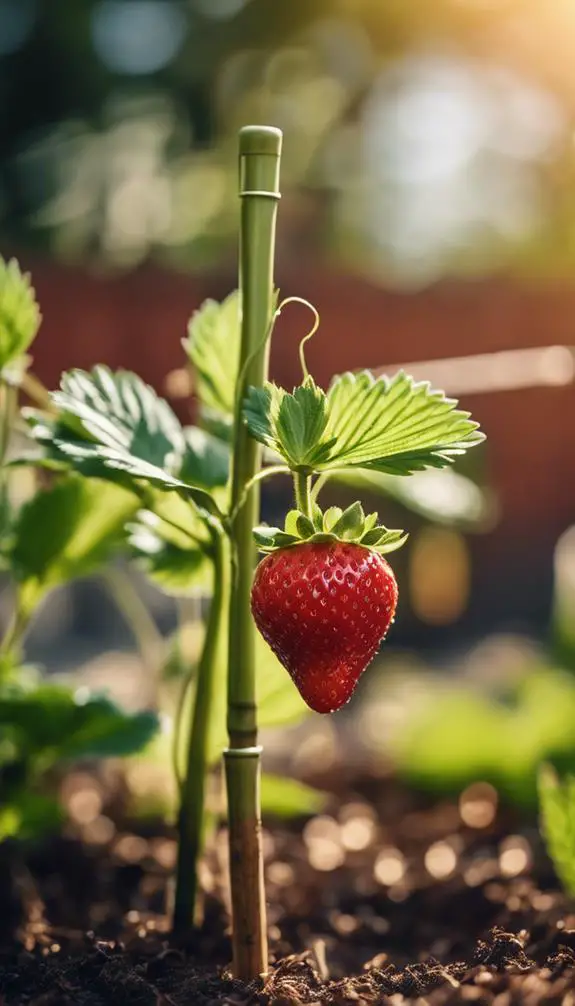
As their runners begin to spread, strawberry plants may need additional support to maintain ideal growth and fruit production.
You'll want to provide support to keep your plants upright and promote even fruiting. Strawberry stakes are a great option, as they allow you to tie up individual plants and keep them organized.
Alternatively, you can use a strawberry trellis, which provides a framework for multiple plants to grow on. This not only keeps your plants tidy but also makes it easier to harvest your strawberries.
Harvesting Strawberries at the Right Time

In the sweet spot between ripeness and decay lies the perfect moment to harvest your strawberries.
Check your plants daily, as strawberry ripeness can change quickly. Gently grasp the fruit and twist it gently; ripe strawberries will come off the plant easily.
Check the color, too – ripe strawberries are bright red, with no white or green spots. Timely picking is vital, as overripe strawberries are more susceptible to mold and rot.
Pick them when they're sweet and slightly soft to the touch. Harvesting at the right time guarantees you'll enjoy the best flavor and texture.
You'll be rewarded with a bountiful harvest if you monitor your plants closely and pick strawberries at their peak ripeness.
Storing and Enjoying Fresh Strawberries
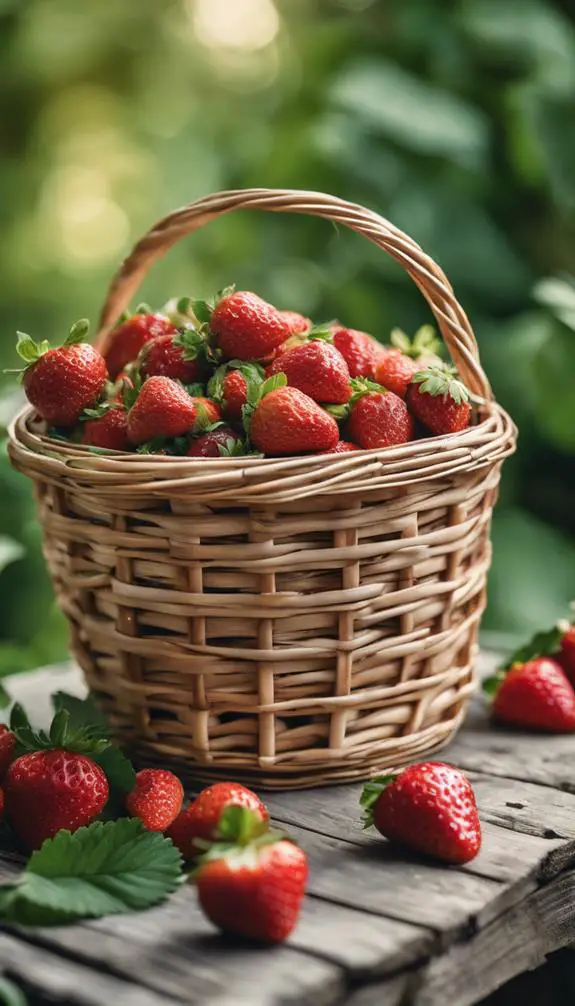
Now that you've successfully harvested your strawberries, it's time to think about how to keep them fresh and enjoy them at their best.
Fresh storage is vital to preserve the flavor, texture, and aroma of your berries. Store them in a cool, dry place, away from direct sunlight and moisture.
You can also use breathable containers or paper bags to maintain air circulation. For longer berry preservation, consider freezing or refrigerating them.
When refrigerating, keep them in a sealed container to maintain humidity. Frozen strawberries are perfect for smoothies, baked goods, or as a sweet topping for oatmeal or yogurt.
FAQs
Can I Grow Strawberries Indoors Without Direct Sunlight?
You can successfully grow plants indoors without direct sunlight by utilizing indoor lighting solutions that mimic natural light, such as LED grow lights or artificial illumination systems, which provide the necessary spectrum and intensity for photosynthesis.
How Often Should I Rotate My Strawberry Containers?
To guarantee ideal strawberry circulation, you'll want to rotate your containers every 7-10 days, promoting even growth and preventing root bound conditions, which will ultimately lead to a rejuvenating container revitalization and a bountiful harvest.
Are Strawberry Plants Susceptible to Frost Damage?
You'll want to protect your plants from early frosts, as strawberry varieties have varying levels of frost tolerance. Some can withstand light frosts, while others are more sensitive, so you must investigate the specific frost hardiness of your strawberry cultivar.
Can I Use Strawberry Jam to Propagate New Plants?
You can't use strawberry jam to propagate new plants, as the jam's sugar content and processing temperatures render the seeds inviable; quality of jam doesn't matter, as seed viability is the limiting factor in this unconventional propagation method.
Do Strawberry Plants Attract Beneficial Pollinators Like Bees?
As you create a pollinator-friendly garden, you'll attract bee friends by incorporating strawberry plants, which serve as a sweet spot on pollinator pathways, providing nectar and shelter for these beneficial insects, ultimately boosting your harvest's success.
Conclusion
You've successfully grown delicious strawberries! Now, enjoy your hard-earned harvest by storing them properly to maintain freshness. Refrigerate unwashed berries in a covered container to keep them fresh for up to 5 days. Freeze or dry strawberries to preserve them for later use. With proper care and maintenance, your strawberry plants will continue to thrive, providing you with a bountiful harvest for years to come.


